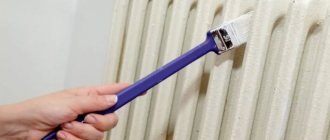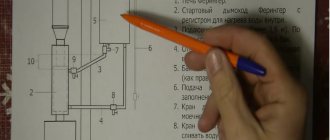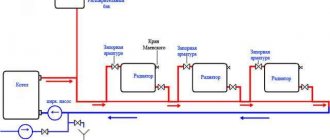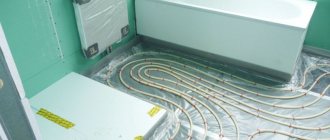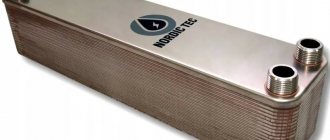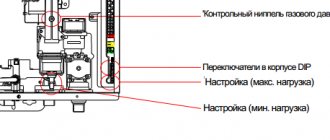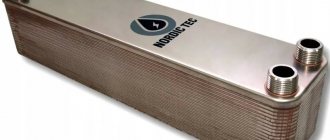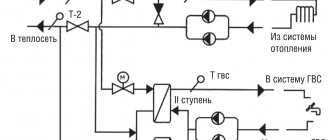Many craftsmen make sauna stoves with their own hands. Not only for the bath, however. To make the stove look presentable, it is better to paint it. Paint not only improves the appearance, but also protects the metal from splashes and reduces its contact with oxygen; oxidation occurs more slowly. Brick stoves are painted less often, especially if they are made of good brick. But sometimes the brick starts to crumble - you were unlucky with the batch, or it overheated. Even more often, cracks occur in the masonry. They are covered with a solution, but to give a more attractive appearance, they are painted over. What is much more often needed for a brick stove is to tidy up the doors: stove casting also rusts. Heat-resistant paint is used for all these needs: for a metal or brick oven or for casting.
The painted homemade metal stove looks quite presentable
Factors that have a negative effect on paint
According to experts, it can reach +600°C in the furnace due to fuel combustion. The steel becomes red hot. Periodic heating and cooling has a detrimental effect on strength indicators. A metal stove in a Russian bath is simultaneously exposed to high humidity and heat; the walls begin to rust inside and out. In a sauna the air is drier, but the air temperature is also higher.
Carbon monoxide can leak into the bathhouse through burnt walls; using an unprotected stove is dangerous to life.
Periodic heating and cooling has a detrimental effect on strength indicators.
Video description
There are other ways to give a stove made of cast iron or ferrous metal a noble look. An example of such a transformation using a cheap folk method is shown in the video:
If you are deciding what paint to paint an iron sauna stove, then you need to choose compounds that are resistant to high and low temperatures and high air humidity. And also those that will not release toxic substances during bath procedures. Silicone enamels best meet these requirements. They cost more than other heat-resistant paints, but they also last longer. However, the service life directly depends on the quality of surface preparation and adherence to coating technology.
What tasks does paint perform?
A layer of paint for a metal sauna stove performs two functions at once: it increases the practicality of the sauna and improves the appearance of the dressing room and steam room. Heat-resistant coatings are resistant to thermal shock and have water-repellent properties.
By the way, welded structures with a tank for water and a firebox are sold in painted or unpainted form. The second option is painted before installation so that the steel does not have time to burn.
A layer of paint for a metal sauna stove performs two functions at once: it increases the practicality of the sauna and improves the appearance of the dressing room and steam room.
DIY painting materials
If there are any reasons why you cannot or do not want to buy special materials for painting the stove, you can start making them yourself.
- Chalk or lime solution. To prepare it, you only need water and lime, which can be purchased in large quantities at any hardware store. The difference between these solutions lies only in the duration of their drying: when applying the first layer of chalk, you must wait for it to dry completely, and layers of lime mortar can be applied immediately. To prepare the solution you will need 1 kg of lime or chalk and 1.5 liters of water. To achieve strength in the final result, table salt must be added to the solution - 300 g of salt per 2 kg of coloring solution. If there is no salt, you can use wood glue - 100 ml of glue per 10 liters of solution, but this paint will be yellowish. To avoid this, you can pour 20 ml of blue into the coloring mixture.
- You can also paint a brick stove using natural varnish. To prepare it, you will need chicken egg whites and milk in a one-to-one ratio, as well as dust from bricks that remains after laying the stove. To process one square meter of stove you need about a quarter liter of milk and 8 egg whites. To prepare this varnish, beaten egg whites and cow's milk are added to brick dust until a thick consistency is formed. The well-mixed solution is applied with a brush to the preheated oven surface. The result is a smooth red coating with increased temperature resistance and durability. To achieve a matte surface structure, you can cover it with drying oil on top. Natural varnish has its drawbacks: when it comes into contact with a painted surface, marks may remain. To prevent this from happening, you can apply an egg white solution on top. Also, during the heating process of the stove, the coating emits the smell of baked milk, which is a disadvantage for most people.
Do I need to paint or is there an alternative?
It is recommended to paint the metal before laying the heat-resistant brick screen and cover the inside of the tank. Instead of painting, bluing is used (details below) or other methods are used:
- Eco-friendly surface treatment with silver is quite effective;
- A budget option is red lead, used in metallurgy;
- A heat-resistant mixture of lime and cement provides good protection against oxidation.
It is recommended to paint the metal before laying the heat-resistant brick screen and cover the inside of the tank.
Characteristics
Before painting a stove in a bathhouse, you should take into account a number of criteria by which paint and varnish materials are selected. There are several of them, each is important in its own way and affects the strength of coatings under the influence of “bath hazards”.
Before painting a stove in a bathhouse, you should take into account a number of criteria by which paint and varnish materials are selected.
Heat resistance
This indicator is indicated on the label in degrees. Manufacturers inform about the maximum heating at which the properties of the film formed after the coloring composition has dried are preserved.
Manufacturers inform about the maximum heating at which the properties of the film are preserved.
Corrosion protection
To prevent the metal from rusting, it is necessary to isolate the alloy from oxygen. Hydrogen increases the brittleness of metals, and nitrogen at high temperatures also has a negative effect on steel.
To prevent the metal from rusting, it is necessary to isolate the alloy from oxygen.
Water repellent properties
Choose paint coatings that repel moisture. This is necessary to prevent oxidation and cracking during the winter.
Choose paint coatings that repel moisture.
Safety
When heated, organic compounds release volatile hydrocarbons; such paints and varnishes can cause poisoning. The bath requires harmless, non-toxic paints and varnishes.
When purchasing paints and varnishes, the choice is made in favor of branded, time-tested products.
The bath requires harmless, non-toxic paints and varnishes.
Mortar
Lime is an accessible material in all respects. Lime solutions have bactericidal properties, and after drying they are absolutely harmless and do not cause irritation of the mucous membranes. Properly prepared lime mortar adheres well to plaster, stone and brick, is not afraid of temperature changes and can be used outdoors and in wet rooms, including baths.
Slaked lime is less dangerous to work with
To prepare the solution, it is better to buy slaked lime in the form of a dry powder. To whitewash oven equipment, it is recommended to use a ten percent salt solution instead of water. Salt makes the coating strong and prevents the formation of cracks.
Lime powder should be diluted in one third of salt water, thoroughly stirring the mass until smooth. If the solution is prepared from lime dough, then it is also diluted with salt water to the consistency of liquid sour cream. To neutralize possible yellowness, it is recommended to add diluted blue.
One liter of lime mortar is enough for about two square meters of area. Accidentally stained floors can be easily washed with clean water, but this must be done immediately, before the lime has time to dry.
Kinds
Heat-resistant paint for sauna stoves is produced in a large assortment. Paint and varnish mixtures are classified according to their basic components:
- Organosilicon coatings form a glass film that retains strength at +800°C, have good adhesion to metal, and are not afraid of water;
- Polyurethane is wear-resistant, can withstand heating up to +600°C, and is often used for boiler equipment. Minus - some compositions change color due to thermal exposure;
- Water-based ones with acrylic filler are more suitable for saunas or painting the stove on the side of the dressing room, where there is no high humidity.
According to user reviews, several heat-resistant coatings deserve attention:
- “Hammerite”, “ELCON” - enamels with corrosion inhibitors;
- “Kudo” enamels with silicon;
- “Hansa” in aerosol cans or cans is produced in about 16 shades;
- Gray or black “Tikkurila” with alkyd resin;
- "Bosni" is a universal composition for many types of surfaces.
For reference. For thin-walled fireboxes, it is recommended to choose coatings with a heat resistance rating of +800...850°C.
Water-based ones with acrylic filler are more suitable for saunas or painting the stove on the side of the dressing room, where there is no high humidity.
Packaging
You can purchase heat-resistant paints in various packaging - these can be spray cans or jars. From cans, paint is simply sprayed over the surface, and from a can, paint is used with brushes, rollers or special sprayers.
The volume of the cylinder is usually 500 ml. Cans are produced in 400 g, 800 g, 2.5 kg and 5 kg. There are also large buckets of 5-15 kg and barrels.
Exactly how to apply thermal paint is everyone’s personal choice. For some, it will be more convenient to use a brush or roller, while others will opt for a spray can. In the latter case, the material consumption will be significantly lower, and the paint will apply more evenly and evenly.
Is it possible to coat equipment with enamel?
Among the large number of paints for a hot water tank in a bathhouse, it is better to choose special enamels marked “KO 8” from leading manufacturers. This means that silicone enamel can withstand high temperatures. Conventional enamels for metal quickly become painted due to temperature changes.
Silicone enamel can withstand high temperatures.
Rules for selection and use
To choose the right paint, you need to determine the maximum temperature of the surface on which it will be applied. You also need to calculate the area and make a choice between a spray in a can and a liquid consistency in a jar. But there are still some rules that you need to know.
Specific nuances in terminology
Many salespeople in their advertising campaigns are very frivolous with the terminology adopted for compositions that can be applied to surfaces with high temperatures. There is no normatively established gradation according to the correspondence between the name of the composition and its maximum permissible heating temperature.
However, three established terms are usually used:
- high temperature;
- heat resistant;
- heat resistant.
High-temperature paints for metal include compositions that can withstand prolonged surface heating up to 200C. They are used for processing radiators and heating pipes, brick stoves and fireplaces. In addition, they are suitable for automotive parts such as engine, muffler and exhaust system.
Water jacket of a metal furnace. From the outside, it does not heat up above the temperature of the coolant, so high-temperature paint can be used to treat its surface
Heat-resistant compounds are used for surfaces with temperatures up to 650C.
These paints are used for the following metal objects:
- sides and bottoms of furnaces;
- barbecues;
- pipes for exhausting combustion products;
- the junction of the water circuit pipes to the furnace or boiler.
Heat-resistant paints and enamels often contain pigments that give them color, so they can be used to create original interior design solutions.
Heat-resistant paint is designed to cover surfaces that are heated to temperatures above 650C. First of all, these are cooking stoves and furnace fireboxes, as well as grates for wood-burning stoves and fireplaces.
Some types of thermal paint have an additional feature - fire resistance. This means that the painted surface may be in direct contact with the flame. Among household metal objects, this is relevant for the fireplace grate and the inside of the barbecue.
Coating instructions
When painting stoves yourself, it is important to follow the sequence of operations and adhere to the technology, then the bathhouse will be protected.
When painting stoves yourself, it is important to follow the sequence of operations and adhere to the technology.
Tools and materials
In addition to paintwork materials and brushes, you will need sandpaper or a metal brush to remove rust, and a solvent to degrease steel. It is necessary to cover the floor and wall so that there are no smudges.
In addition to paintwork materials and brushes, you will need sandpaper or a metal brush to remove rust, and a solvent to degrease steel.
Surface preparation
The metal is pre-cleaned to a metallic shine. After removing dust, wipe the surface with a solvent.
Stainless steel fittings and adapters are coated with grease to protect them from staining.
The metal is pre-cleaned to a metallic shine.
Work algorithm
Mix the paint before use, start painting from hard-to-reach places, then cover the remaining areas. Coatings are applied in one layer, unless otherwise specified by the manufacturer.
The paint is mixed before use.
How long does it take for the coating to dry and after what time can it be heated?
It is better to wait 5 days after painting, only then start lighting the stove. Paint for a metal stove in a bathhouse dries on average from 72 to 96 hours, depending on the plasticizer.
Some coatings dry only when heated; the stove is lit, but not allowed to become very hot. For safety, open the window and door.
It is better to wait 5 days after painting, only then start lighting the stove.
How to paint a potbelly stove
The choice of finishing materials will directly depend on the imagination and interior of the house, as well as on the basis of the financial situation. It is also worth considering the material on which the potbelly stove is made. For example, for a brick stove, lime is ideal; for a metal stove, the paint must be heat-resistant. If you don’t want to bother with the coloring process, then you can use heat-resistant varnish with silver, bronzing with drier or liquid glass.
Note: Please ensure that the paint does not emit toxic fumes during use!
Burnishing an iron stove
Blueing is the etching of metal with phosphoric acid, which creates a protective layer of phosphates on the steel. A similar technology is applicable in baths. The cleaned, degreased metal surface is treated with a solution of phosphoric acid. Add 150 ml of acid and 4 g of butyl alcohol per liter of water. After the solution has dried, the metal is washed with laundry soap. Then the surface is heated to 150 C, and a 10% solution of caustic soda is applied to them using a spray gun.
Blueing is the etching of metal with phosphoric acid, which creates a protective layer of phosphates on the steel.
If desired, the metal stove and tank can be made into decorative parts of the bathhouse interior. For painting, it is better to choose heat-resistant enamels, which are durable and decorative. There will be no rust with this coating.
Painting procedure
Now you can start painting the potbelly stove. Before applying heat-resistant silicon-organic enamel, make sure that the prepared solution is not too thick. If you coat the surface with a viscous compound, it will not absorb well into the surface. In addition, such paint is quite difficult to work with. Therefore, first dilute it using a solvent specially created for organic materials. If you do not have such a solvent, you can dilute the paint using ordinary turpentine.
When the required thickness has been achieved, begin painting the potbelly stove. The paint should be applied in a fairly thin layer and wait until it dries completely. Then you need to apply a second layer. If the enamel lays down in an even layer through which the brick cannot be seen, you can complete painting at this stage. If the bricks are still visible, then you will need to apply an additional layer, and only after that paint the cast iron structural elements.
